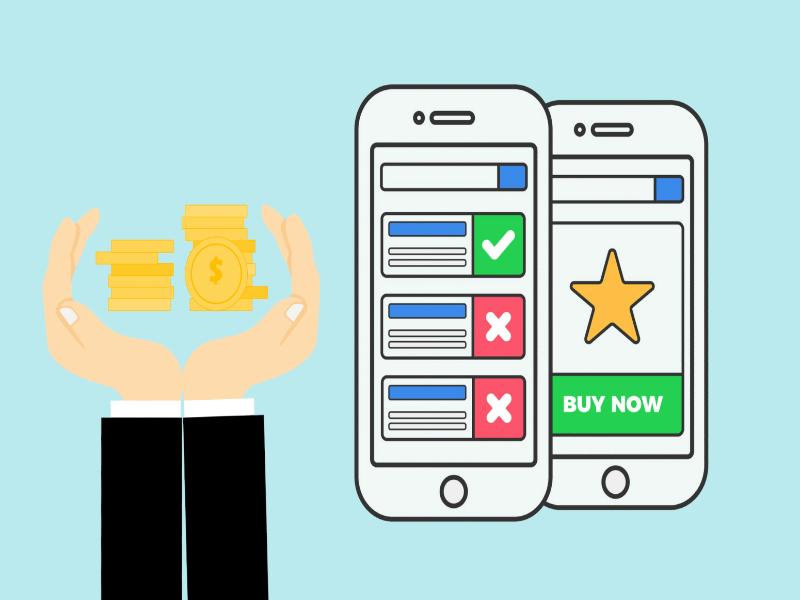Mobile App Monetization Strategies Revealed
Did you know that the global mobile app industry is projected to generate over $935 billion in revenue by 2023?
With the increasing popularity of smartphones and the growing demand for mobile applications, it has become more important than ever for app developers to implement effective monetization strategies to maximize their app’s earning potential.
Key Takeaways (Mobile App Monetization Strategies)
- Implementing in-app purchases can be a lucrative revenue stream for mobile apps.
- Mobile ad networks play a crucial role in app monetization, but careful integration is essential for a positive user experience.
- App store optimization is vital to improving app discoverability and driving organic downloads.
- Analyzing mobile app analytics can provide valuable insights for optimizing revenue generation.
- Considering alternative monetization strategies, such as subscription models and sponsorships, can offer additional revenue opportunities.
Understanding App Monetization
App monetization is a crucial aspect of a mobile app’s success. To effectively monetize your app, it’s important to understand the various strategies and models available.
Below we will provide a comprehensive overview of app monetization, including different models and options that can help you generate revenue.
App Monetization Models
When it comes to monetizing your mobile app, there are several models to consider. Each model has its advantages and considerations, and choosing the right one depends on factors such as your app’s niche, target audience, and monetization goals.
Let’s explore some popular app monetization models:
- Freemium Model: In this model, the app is offered for free, but certain features or content are locked or available to premium users who pay a fee. Freemium models allow you to attract a large user base while still generating revenue from in-app purchases.
- In-App Advertising: This model involves displaying ads within the app to generate revenue. Ad formats can include banner ads, interstitial ads, native ads, and rewarded video ads. Integrating mobile ad networks can help optimize ad display and maximize ad revenue.
- Subscription Model: With a subscription model, users pay a recurring fee to access premium features, content, or services. This model provides a steady revenue stream and is suitable for apps that offer ongoing value.
- In-App Purchases: In-app purchases allow users to buy additional content, virtual goods, or upgrades within the app. This model is commonly used in mobile games and other apps that offer a range of premium features.
Choosing the Right Monetization Strategy
When selecting a monetization strategy for your app, it’s important to consider your target audience, the nature of your app, and your revenue goals.
Conduct market research, evaluate competitor apps, and analyze user behavior to make informed decisions about the most suitable approach. Keep in mind that you can also combine multiple monetization models to diversify your revenue streams.
Next, we will explore specific app monetization strategies in more detail, such as leveraging in-app purchases and exploring mobile ad networks.
By understanding these strategies and their implementation, you’ll be equipped to make informed choices and maximize your app’s revenue potential.
Leveraging In-App Purchases
In this section, we’ll explore the power of in-app purchases as a revenue stream for mobile apps.
In-app purchases are a popular monetization strategy that allows app developers to offer additional content, features, or virtual goods within their app, enticing users to spend money to enhance their experience.
The Freemium Model
One of the most effective ways to implement in-app purchases is through the freemium model. This model offers the core features of the app for free, while providing optional paid upgrades or premium content.
By offering a free version of the app, you can attract a wider user base and encourage users to make in-app purchases to unlock additional functionality or access exclusive content.
Pricing Strategies
When it comes to pricing your in-app purchases, it’s important to strike a balance between affordability and value. Consider offering a range of price points to cater to different user segments.
For example, you can offer a basic package at a lower price and a premium package with more features or content at a higher price. This allows users to choose the option that best fits their needs and budget.
Upselling Techniques
To maximize in-app purchase revenue, it’s crucial to employ upselling techniques strategically. Upselling refers to the practice of offering users additional upgrades or premium content after they have made an initial in-app purchase.
This can be done through targeted recommendations based on user preferences or by highlighting the benefits of upgrading to a higher tier.
To illustrate the potential revenue impact of in-app purchases, let’s consider the following example:
| App Name | Number of Downloads | Conversion Rate to In-App Purchases | Average Revenue per Purchase | Total In-App Purchase Revenue |
|---|---|---|---|---|
| Trivia Master | 500,000 | 5% | $2.99 | $74,750 |
Table: Example of potential in-app purchase revenue for the app Trivia Master
In this example, Trivia Master has 500,000 downloads and a conversion rate of 5% to in-app purchases. With an average revenue of $2.99 per purchase, the app can generate a total in-app purchase revenue of $74,750.
By leveraging in-app purchases and implementing a freemium model, you can unlock a significant revenue stream for your mobile app. The key is to provide value, offer appealing upgrades, and incentivize users to make in-app purchases to enhance their app experience.
Exploring Mobile Ad Networks
Mobile ad networks play a crucial role in-app monetization. They offer app developers an effective way to generate revenue through mobile app advertising.
By partnering with reliable and reputable ad networks, developers can integrate ads seamlessly into their apps, reaching a wider audience and maximizing their earning potential.
When it comes to mobile ad networks, there are various types to consider, each with its pros and cons. Let’s explore some of the popular mobile ad networks:
Type 1: Display Ad Networks
Display ad networks, such as Google AdMob and Facebook Audience Network, allow app developers to display graphical ads within their apps. These ads can be banners, interstitials, or native ads that blend seamlessly with the app’s interface.
Type 2: Video Ad Networks
Video ad networks, like Vungle and Unity Ads, provide app developers with the opportunity to monetize their apps through video ads. These engaging and interactive ads are typically shown before, during, or after app content, allowing developers to earn revenue based on ad views or user interactions.
Type 3: Rewarded Ad Networks
Rewarded ad networks, such as IronSource and Tapjoy, offer users an incentive, such as virtual currency or extra content, in exchange for engaging with ads. This approach creates a win-win situation, as users are rewarded for their time, and app developers can generate revenue while enhancing user engagement and retention.
Integrating ads effectively into your app is crucial to maintain a positive user experience. Here are some tips to consider:
- Choose relevant ad formats that align with your app’s content and user preferences.
- Implement frequency capping to avoid overwhelming users with excessive ads.
- Utilize targeting options to deliver personalized ads that resonate with your audience.
- Optimize ad placement to ensure ads are non-intrusive and seamlessly integrated into the app’s flow.
- Regularly analyze ad performance and make necessary adjustments to maximize revenue.
| Mobile Ad Network | Features | Integration | Pros | Cons |
|---|---|---|---|---|
| Google AdMob | Banner, interstitial, native ads | SDK integration | Wide reach, robust analytics, high-quality ads | Can be competitive, requires careful ad placement |
| Facebook Audience Network | Banner, interstitial, native ads | SDK integration | Access to Facebook’s vast user base, precise targeting | Strict ad review process, limited monetization options |
| Vungle | Video ads | SDK integration | High eCPMs, engaging ads, global reach | Can increase app size, requires careful ad placement |
| Unity Ads | Video ads | SDK integration | Seamless Unity engine integration, high eCPMs | Focused on gaming apps, limited ad targeting options |
| IronSource | Rewarded ads | SDK integration | Monetizes non-paying users, flexible ad options | Requires user opt-in for rewarded ads |
| Tapjoy | Rewarded ads | SDK integration | Offers a wide range of ad formats, strong user engagement | Can be challenging to find relevant offers for all users |
By strategically selecting and integrating mobile ad networks, app developers can effectively monetize their apps while ensuring a positive user experience.
How to Craft Intuitive End-User Experiences
Understanding the different types of mobile ad networks and exploring the pros and cons of each empower developers to make informed decisions that align with their app monetization goals.
Optimizing App Store Presence
App store optimization (ASO) plays a crucial role in enhancing your app’s visibility and driving organic downloads.
By implementing effective ASO strategies and utilizing top mobile app monetization platforms, you can maximize your app’s discoverability and ultimately boost your revenue.
Below we’ll explore ASO techniques, share tips for improving app visibility in app stores, and present the top mobile app monetization platforms available.
App Store Optimization (ASO) Strategies
When it comes to ASO, several techniques can help improve your app’s performance in app store search results. Here are some key strategies to consider:
- Keyword Research: Conduct thorough keyword research to identify relevant and high-performing keywords for your app. Include these keywords strategically in your app’s metadata, such as the app title, description, and keywords field.
- App Title and Description: Craft an engaging and informative app title and description that effectively conveys your app’s value proposition. Optimize your app description with relevant keywords while maintaining readability.
- App Icon and Screenshots: Design an eye-catching app icon and create visually appealing screenshots that highlight your app’s features and benefits. Use compelling imagery to capture the attention of potential users.
Tips for Improving Visibility in App Stores
While ASO is important, visibility in app stores goes beyond keywords and metadata. Here are some tips to help improve your app’s visibility:
- App Ratings and Reviews: Encourage users to leave positive reviews and ratings, as they can significantly impact your app’s visibility and credibility.
- App Localization: Consider localizing your app’s metadata and content to target specific regions and maximize reach in different markets.
- App Updates: Regularly update your app with bug fixes, new features, and improvements to demonstrate ongoing development and attract more users.
Top Mobile App Monetization Platforms
When it comes to monetizing your app, partnering with reliable mobile app monetization platforms can help you generate revenue effectively. Here are some top platforms to consider:
| Platform | Key Features |
|---|---|
| AdMob | Google’s mobile ad network that offers various ad formats and targeting options. |
| AppLovin | A comprehensive mobile app monetization platform that provides ad mediation, in-app bidding, and user acquisition solutions. |
| Mopub | A leading ad monetization platform that offers programmatic ad auctions and mediation for maximizing ad revenue. |
| IronSource | An all-in-one monetization platform that integrates ad networks, mediation, and user acquisition solutions. |
Selecting the right mobile app monetization platform can greatly impact your app’s revenue potential. Evaluate these platforms based on your specific needs and goals to make an informed decision.
Harnessing Mobile App Analytics
In today’s fast-paced app market, understanding user behavior is critical to optimizing your app’s monetization strategy.
That’s where mobile app analytics come in. By harnessing the power of analytics, you can gain valuable insights into user preferences, identify areas for improvement, and make data-driven decisions to drive revenue generation.
Importance of Mobile App Analytics
Mobile app analytics give you a comprehensive view of how users engage with your app. With the right analytics tools, you can track user actions, measure app performance, and gather user demographic data.
This information is invaluable when it comes to understanding your target audience and optimizing your app’s revenue potential.
Key Metrics to Track
When it comes to app monetization, certain metrics are particularly important to monitor. Here are some key metrics you should track:
- User Acquisition: Understanding where your users come from can help you optimize your user acquisition strategy and allocate resources effectively.
- Engagement and Retention: Tracking user engagement and retention metrics allows you to identify areas for improvement and implement strategies to keep users coming back.
- Conversion Rates: Monitoring conversion rates from free to paid users or from users to subscribers gives you valuable insights into the effectiveness of your app’s monetization funnel.
- Revenue per User: Calculating the average revenue generated per user helps you understand the effectiveness of your current monetization strategy and identify opportunities for increasing app revenue.
Leveraging Analytics to Optimize Revenue Generation
Once you have gathered data through mobile app analytics, it’s essential to leverage this information to optimize your app’s revenue generation. Here are a few strategies to consider:
- Personalization: Use analytics to understand user preferences and deliver personalized experiences and offers that can drive increased engagement and revenue.
- A/B Testing: Analyze user behavior to test different app monetization strategies and determine which ones yield the best results.
- Optimizing Ad Placements: By analyzing user interaction data, you can identify the most effective ad placements within your app to maximize revenue without compromising the user experience.
- Identifying In-App Purchase Opportunities: Analyzing user behavior can reveal opportunities to introduce new in-app purchase options or optimize existing ones to boost revenue.
By harnessing the power of mobile app analytics, you can unlock valuable insights about your users, their preferences, and their behavior within your app.
This knowledge will enable you to make informed decisions, optimize your app’s monetization strategy, and ultimately, maximize your app’s revenue potential.
| Metric | Description |
|---|---|
| User Acquisition | The number of new users acquired and their acquisition source. |
| Engagement and Retention | Metrics such as session duration, screen flow, and user retention rates. |
| Conversion Rates | The percentage of users who convert from free to paid or from users to subscribers. |
| Revenue per User | The average revenue generated per user over a specific period. |
Implementing Subscription Models
Subscription models have emerged as a highly effective revenue stream for mobile apps. By offering recurring subscription options to your users, you can establish a stable and predictable income flow.
Now we will explore different subscription models, and pricing structures, and guide how to successfully implement a subscription model in your app, maximizing your app revenue potential.
Types of Subscription Models
When considering subscription models for your app, it’s important to understand the various options available. Here are some common types of subscription models:
- 1. Paywall Subscription: Users are required to pay a recurring fee to access premium content or features within the app.
- 2. Membership Subscription: Users pay a monthly or yearly fee to become a member of your app, unlocking exclusive benefits and perks.
- 3. Tiered Subscription: Offer different subscription tiers with varying levels of access and features, allowing users to choose the option that best suits their needs and budget.
By offering different subscription models, you can cater to a wider range of users and increase the chances of monetizing your app effectively. It’s essential to analyze your target audience’s preferences and needs to determine the most suitable subscription model for your app.
Optimizing Pricing Structures
Pricing plays a crucial role in the success of your subscription model. You need to strike a balance between generating revenue and providing value to your users. Here are some factors to consider when optimizing your pricing structure:
- 1. Research your competitors’ pricing strategies to understand industry norms and user expectations.
- 2. Consider the unique value proposition of your app and the benefits offered through the subscription model.
- 3. Conduct A/B testing to gauge user interest and willingness to pay at different price points.
By carefully analyzing these factors, you can determine an optimal pricing structure that encourages users to subscribe while maximizing your app’s revenue.
Implementing a Successful Subscription Model
| Steps to Implement a Successful Subscription Model |
|---|
| 1. Define the value proposition of your subscription model and communicate it clearly to users. |
| 2. Offer a free trial period to allow users to experience the benefits of your subscription. |
| 3. Provide ongoing updates, improvements, and exclusive content to keep subscribers engaged. |
| 4. Continuously monitor and analyze subscription performance to identify areas for improvement. |
| 5. Leverage user feedback to iterate and refine your subscription model over time. |
By following these steps and continuously optimizing your subscription model, you can create a sustainable revenue source for your mobile app.
Integrating Sponsorship and Partnerships
Collaboration with sponsors and partners offers a valuable opportunity to diversify your app monetization strategy.
By identifying potential partners, negotiating sponsorship deals, and effectively integrating sponsored content into your app, you can generate additional revenue while delivering value to your users.
Identifying Potential Partners
When seeking sponsors and partners for your app, it’s essential to find alignment between their brand and your target audience. Consider companies or organizations that share similar values or cater to a similar customer base.
Conduct thorough research to identify potential partners who can bring value to your app and benefit from the exposure to your user base.
Negotiating Sponsorship Deals
Once you’ve identified potential partners, it’s crucial to approach them with a compelling sponsorship proposal. Highlight the unique features and benefits of your app that align with their brand.
Communicate the value they will receive from the partnership, such as increased brand visibility, access to a targeted audience, or potential customer acquisition. Negotiate mutually beneficial terms, ensuring a fair exchange of value for both parties involved.
Effectively Integrating Sponsored Content
Integrating sponsored content into your app should be seamless and non-intrusive to maintain a positive user experience. Consider the user flow and app design when determining the placement of sponsored content.
Label sponsored content to maintain transparency with your users. It’s important to strike a balance between promoting sponsored products or services and providing genuine value to your users.
By delivering sponsored content in a way that aligns with the overall app experience, you can create a win-win situation for both your users and the sponsoring partner.
| Benefits of Integrating Sponsorship and Partnerships | Considerations |
|---|---|
| Additional revenue streams Increased brand exposure Access to a wider user base Potential for long-term partnerships | Select partners that align with your app’s values Ensure the sponsored content enhances, rather than disrupts, the user experience Transparency with users regarding sponsored content Regularly review the effectiveness of partnerships and adjust as necessary |
Considering Alternate Monetization Strategies
Let’s explore alternative monetization strategies that can help you maximize your app’s revenue potential. By adopting these strategies, you can diversify your app’s income streams and attract a wider audience. Some of the key strategies we’ll discuss include:
- Hybrid Models: Combining different app monetization methods can be a powerful strategy. By offering a mix of in-app purchases, ads, and subscriptions, you can cater to different user preferences and generate revenue from multiple sources.
- One-Time Payments: While many apps offer free downloads with in-app purchases, charging a one-time fee for access to premium features or content can be an effective strategy. This approach works well for apps that provide unique or highly specialized services.
- In-App Crowdfunding: Crowdfunding platforms have gained popularity among app developers as a way to raise funds and monetize apps. By offering exclusive rewards or early access to app features, you can incentivize users to contribute to your app’s development.
Conclusion
Effectively implementing mobile app monetization strategies is essential for maximizing your app’s revenue potential.
Through a combination of methods such as in-app purchases, mobile ad networks, app store optimization, and leveraging mobile app analytics, you can successfully monetize your app and achieve long-term financial success.
In-app purchases allow you to offer additional features or content to users, creating a revenue stream while enhancing the user experience. By implementing a freemium model and employing pricing and upselling strategies, you can optimize revenue generation.
Mobile ad networks provide opportunities for app monetization through targeted advertising. It’s crucial to integrate ads seamlessly into your app while ensuring a positive user experience.
Good ad placement and selection of mobile ad networks can significantly impact your app’s revenue.
App store optimization is key to improving your app’s discoverability in crowded app stores. By optimizing your app’s metadata, keywords, screenshots, and ratings, you can enhance visibility and drive organic downloads.
Additionally, leveraging mobile app analytics can provide valuable insights into user behavior and preferences, helping you make data-driven monetization decisions.
Consider implementing subscription models that offer recurring revenue for your app. By setting appropriate pricing structures and offering compelling content, you can attract and retain subscribers, creating a stable income source.
Expand your monetization potential by exploring sponsorship and partnership opportunities. Collaborating with sponsors and integrating sponsored content can generate additional revenue and build meaningful relationships within your app’s niche.
Finally, don’t be afraid to consider alternative monetization strategies. Hybrid models, one-time payments, and in-app crowdfunding are innovative approaches that may suit your app and target audience.
Stay up to date with emerging mobile app monetization platforms that offer fresh ways to generate revenue.
By implementing a comprehensive mobile app monetization strategy, you can unlock your app’s full financial potential and pave the way for long-term success in the competitive app market.







